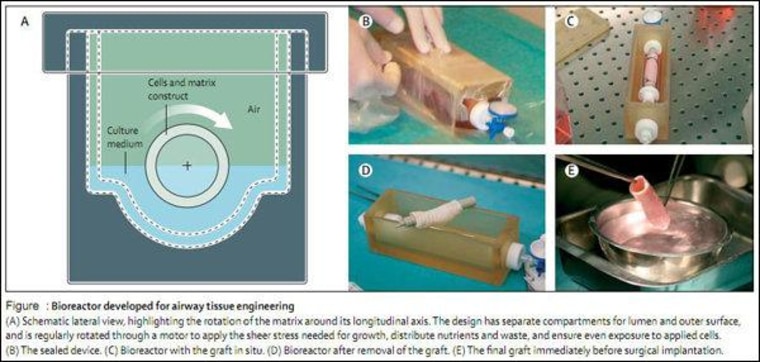Speaking of the coming wonders, did you catch the headline on Friday that the first synthetically grown transplant was performed? Actually, from what I gather, the procedure was performed on June 9 and the patient was released from the hospital on Friday.
Scientists used a synthetic lattice coated in the recipient's own stem cells to grow him a new trachea which they then successfully implanted, replacing his cancerous one, without the fear of rejection that comes with transplants that come from organ donors.
The funny thing is that this almost isn't even news. Discover's round-up of links on the story include regular mainstream press, not just futuristic tech blogs. USA Today cites George Daley, director of stem cell transplantation at Children's Hospital Boston as saying, "The scientific advance is pretty minimal. Tissue engineers have been marrying cells to matrices to regrow parts for many years."
So, Ok fine. Been there done that with the new organ growing. What's amazing to me, though, is that they made this trachea in two days. Doesn't it take longer than that to grow one... the first time?
The image above is from a 2008 paper (pdf) co-authored by Paolo Macchiarini, professor of regenerative surgery at the Karolinksa Institute in Stockholm, the doctor who led the team that did this most recent operation. In the 2008 case they used a donor trachea, cleaned down to its basic structure and regrown with the donor's stem cells, again to avoid rejection problems. In the new case, they constructed that starter skeleton artificially, but the growing process was the same. They put the framework on a sort of rotisserie that rotates the structure through what is in some places referred to as the "cell broth" (ew) and, like dipping a candle, it's soon coated with stem cells. There's an intermediate step where the cells are coaxed to differentiate into whatever role they play in the trachea and it's implanted while still in the process of becoming what will eventually be a real, viable organ.
This is probably inappropriate to say in the face of the normalizing of a medical miracle, but do you remember the resurection of Frank scene from the first Hellraiser movie? (Note: horror movie guts)
